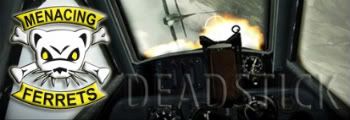
 |
|
#11
|
|||
|
|||
|
Horsepower output of a DB601Aa at very low alt: 1175hp with 1min emergency boost at 2500rpm
with full power (without boost) it would be 1015hp at 2400rpm for 5min. |
|
#12
|
|||
|
|||
|
There's a small control bug with the 109E-3 when antropomorphic controls are enabled: using the flap wheel you can't trim the tailplane at the same time with the other wheel, but in reality both were located on the same place for exactly this reason: so they could be operated at the same time by the left hand. Pilot could thus compensate for trim changes occuring from lowering the flaps.
It should be changed that using the flaps do not disable elevator trim on 109E. " Longitudinal trimming is effected by means of an adjustable tailplane having a 12 deg. incidence range and operated mechanically from a handwheel on the pilot's left; this wheel is mounted concentrically with the flap-actuating wheel, and by winding both wheels together the pilot automatically compensates for the change of trim due to flaps. ... 4.23. Longitudinal. – The adjustable tailplane is controlled from a 11.7-in. diameter wheel on the pilot's left (Fig. 3) ; 5.75 turns are required to move the tailplane through its full angular range (+ 3.4 deg. to - 8.4 deg.) and the wheel rotation is in the natural sense, i.e. winding forward pushes the nose of the aircraft down." http://www.kurfurst.org/Tactical_tri...ls/Morgan.html
__________________
Il-2Bugtracker: Feature #200: Missing 100 octane subtypes of Bf 109E and Bf 110C http://www.il2bugtracker.com/issues/200 Il-2Bugtracker: Bug #415: Spitfire Mk I, Ia, and Mk II: Stability and Control http://www.il2bugtracker.com/issues/415 Kurfürst - Your resource site on Bf 109 performance! http://kurfurst.org 
|
|
#13
|
|||
|
|||
|
Quote:
We start with both oil and water radiators at 80°, and we keep these temperatures during all the flight. Throttle fixed at 100% and we work with the PP to keep 2000/2100 RPM. Speed 260km/h. At something like 2,5km of altitude we start to see light shakes (something like one every 5 seconds) and this goes worser the more alt we gain (finally we have a shake every second) Initially we thought it was a problem of wind or turbolence but at those altitudes the air should be quite (at 5km the shaking is unstoppable) Because of this our speed falls and after a pair of minutes we have backfire problems. So we tried to turn down the throttle and the shakes disappear, but can't pull it up that the shaking starts again. If you have a backfire problem from a exhaust how do you act? I tried to close the fuel but the flames are still there...
__________________
 A whole generation of pilots learned to treasure the Spitfire for its delightful response to aerobatic manoeuvres and its handiness as a dogfighter. Iit is odd that they had continued to esteem these qualities over those of other fighters in spite of the fact that they were of only secondary importance tactically.Thus it is doubly ironic that the Spitfire’s reputation would habitually be established by reference to archaic, non-tactical criteria. |
|
#14
|
|||
|
|||
|
I assume the engine preasure is to high to a long time. Keep it to max 1.25 ATA (so says the manual) while travelling.
|
|
#15
|
||||
|
||||
|
Quote:
As the air gets thinner the higher you go, and as your engine needs air to breath to work efficiently, you will lose power the higher you go. BUT there were these things called superchargers, which gave the engine extra boost at high altitude. The 109E had an absolute service ceiling of around 32,000ft (9,700m), and I guess performance was pretty sloppy that high, but you should be able to get to around 20,000ft (6000m) before performance starts dropping off noticeably. Here is a link to British evaluation tests of captured 109Es: http://kurfurst.org/Tactical_trials/...ls/Morgan.html The first graph shows climb performance.
__________________

|
|
#16
|
|||
|
|||
|
If what you guys are reporting is true about lowering propeller pitch to gain the best speed out of the aircraft then something is wrong. That's anti-thetical to the physics/chemistry of a constant speed prop. A propeller should develop max rated thrust at it's max rated RPM. End of story.
|
|
#17
|
|||
|
|||
|
Quote:
|
|
#18
|
|||
|
|||
|
Quote:
This is completley incorrect in the mooney M20j. |
|
#19
|
|||
|
|||
|
Quote:
Winger |
|
#20
|
||||
|
||||
|
Wonder if there is a bug with the mixture...Its auto so we can't change it,but it sounds like the mix is too rich at altitude.
|
 |
|
|